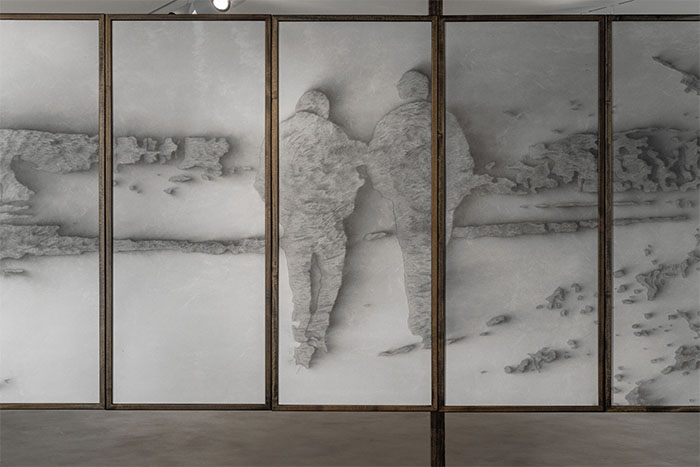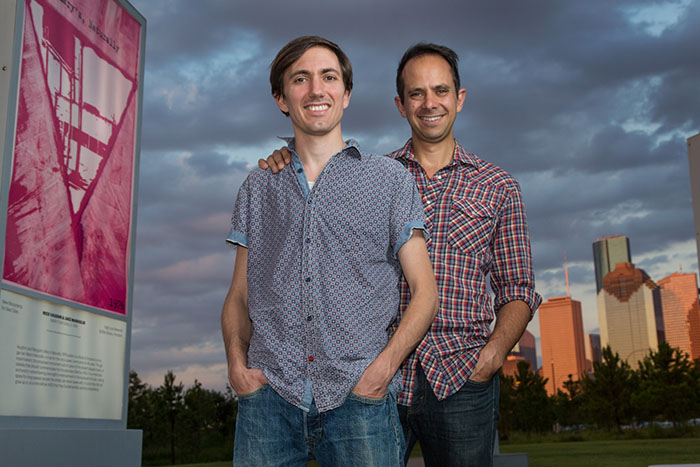In 1978, around 4,000 LGBTQIA+ Houstonians convened at the Astro Arena. Town Meeting I galvanized the LGBTQIA+ rights movement, ultimately leading to the creation of major local institutions such The Montrose Center and The Montrose Clinic (now Legacy Community Health). Three years from now, during the 50th anniversary of this pivotal event, artists Nick Vaughan & Jake Margolin are facilitating a program to commemorate, celebrate, and reinvigorate the community, and they want you to be a part of it.
The process begins with an upcoming exhibition and symposium hosted by the duo at Art League Houston supported by Vaughan & Margolin’s newly minted organization the Rendezvous Center for Art. On view from May 16 – July 11, 2025, Town Meeting 1978-2028 will feature a wind drawing composed of archival images from the original Town Meeting.
“The wind drawings feel like they have a capacity to hold the ambiguity, the ambivalence, the stickiness of the narratives we’re working with,” Vaughan explained. “They’re beautiful, they’re delicate, they’re sad, they’re violent, they’re both an erasure and a mark-making, readable and obscure. Functionally the image is only actually made through the process of its erasure.”
“It feels to me like one of the biggest issues we’re facing in progressive politics, in community building, in basic social discourse, is an entirely reasonable and not at all surprising defensive posture that we’ve all built over the last two months, year, decade,” Vaughan said. What’s taking place at the national level now is something that’s been happening in the Texas legislature for years, leaving communities with a feeling of being under constant threat, so “we’ve all built layers of coping and armor, and distrust, and I think, it’s showing itself to be a pretty major obstacle to deep productive community organizing.”
One aspect of this is that many organizations and communities silo themselves, focusing solely on one arena because there is always something to react to, something to push back against. Unfortunately, when you’re always on the back foot, you’re rarely making progress.
But, part of the beauty of the drawings is that they come into focus when they aren’t the focus, when you blur your eyes or look away for a moment to glance from your periphery. When the future feels blurry, it can feel like a loss of purpose, but a vague vision of utopia offers direction, a goal to work towards. That requires more than pillars and silos, though.
1 ⁄6

Nick Vaughan & Jake Margolin, Excerpt from Town Meeting
Full Drawing 48"x1056" (4'x88')
charcoal powder and wind on paper
2025
2 ⁄6

Nick Vaughan & Jake Margolin, Excerpt from Town Meeting
Full Drawing 48"x1056" (4'x88')
charcoal powder and wind on paper
2025
3 ⁄6

Nick Vaughan & Jake Margolin
Microphones from Town Meeting 1, 1978.
Image courtesy of the artists.
4 ⁄6

Nick Vaughan & Jake Margolin
The North Platte River, 2022
Charcoal Powder And Wind On Paper, 62 x 312
5 ⁄6

Nick Vaughan & Jake Margolin
The North Platte River (detail), 2022
Charcoal Powder And Wind On Paper, 62 x 312
6 ⁄6

Nick Vaughan & Jake Margolin
Photo by Janice Rubin
The wind drawing will surround a modular conference table modeled after the segments of the iconic bar top from Mary’s Naturally. The conference table will anchor the two-day symposium, set for June 7-8 at Art League, as the artists seek to inspire and seed a new wave of artistic organizing and cross-community collaborations.
“We’ve often spoken of Mary’s as ‘The Stonewall Inn’ of Houston,” Margolin explained. “Now while I wouldn’t for a second argue that Mary’s was representative of all of Houston’s queer culture, there is a certain magic in those bar tops, and the unfathomable depth of the stories contained in its resin-coated collage of photographs.”
These are the histories that Vaughan & Margolin dedicate their artistic practice to, digging into untold stories to create a “catalogue of ghosts, and forebears, and crazy uncles” that spins out into a constellation of queer histories from communities across the country.
The ghost versions of the bar top tie the symposium participants back to the hub of queer activism in Houston. Their goal in this is not to tell people what to do or lead the way but spark ideas for projects to culminate in 2028 as part of the 50th anniversary of Town Meeting I.
“We hope that people come out of it having met or reconnected with co-conspirators/kindred spirits to undertake these endeavors with,” Margolin said, with Vaughan adding, “I hope people take away some degree, even if it’s small, of optimism. Of the memory that we’ve dealt with this shit before, that we have power, that we have agency, that we can imagine utopian futures even while fighting the onslaught of abuse and malice being heaped upon us, and that community, that gathering, that family, can hold us in that fight.”
—MICHAEL McFADDEN




